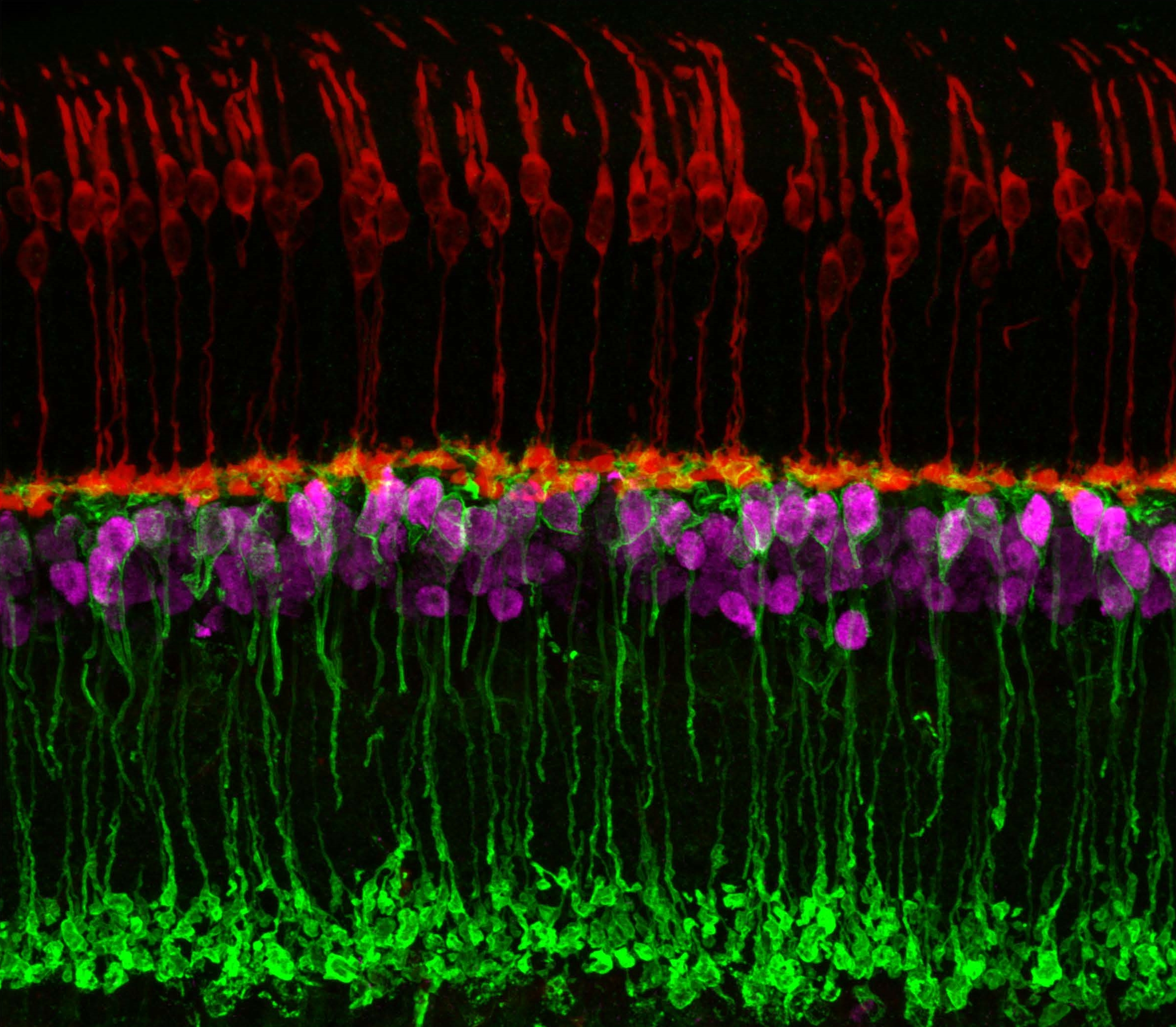Creative Minds: Reprogramming the Brain
Posted on by Dr. Francis Collins

Caption: Neuronal circuits in the mouse retina. Cone photoreceptors (red) enable color vision; bipolar neurons (magenta) relay information further along the circuit; and a subtype of bipolar neuron (green) helps process signals sensed by other photoreceptors in dim light.
Credit: Brian Liu and Melanie Samuel, Baylor College of Medicine, Houston.
When most people think of reprogramming something, they probably think of writing code for a computer or typing commands into their smartphone. Melanie Samuel thinks of brain circuits, the networks of interconnected neurons that allow different parts of the brain to work together in processing information.
Samuel, a researcher at Baylor College of Medicine, Houston, wants to learn to reprogram the connections, or synapses, of brain circuits that function less well in aging and disease and limit our memory and ability to learn. She has received a 2016 NIH Director’s New Innovator Award to decipher the molecular cues that encourage the repair of damaged synapses or enable neurons to form new connections with other neurons. Because extensive synapse loss is central to most degenerative brain diseases, Samuel’s reprogramming efforts could help point the way to preventing or correcting wiring defects before they advance to serious and potentially irreversible cognitive problems.
The human brain is wired with a vast number of circuits. They travel winding, contorted paths through the densely packed neurons in the human brain, making them extremely difficult to study. Samuel will start in less expansive and daunting neural terrain. She has chosen to focus first on synapses in the mouse retina, the complex neural tissue that lines the back of the eye. The retina is also a good place to start because some of its circuits can restructure to help keep them in working order.
As a postdoctoral student, Samuel discovered that two specific proteins are needed to maintain healthy synapses in the retinas of older mice. This suggested it might be possible to target particular molecules and pathways to keep neural cells of the retina connected and doing their job [1]. Because previous studies have shown parallels between pathways in the retina and brain, Samuel began thinking that similar molecules and pathways might exist in the brain.
Now, Samuel will use the New Innovator Award to look for more of these essential proteins in the mouse retina to provide leads for future studies in humans. As part of the effort, Samuel and her colleagues will develop a range of specialized technologies to manipulate and visualize individual synapses in the retina. Among them are state-of-the-art 3D imaging tools that will allow them to map the locations of individual molecules inside a synapse.
In another project, Samuel’s team will systematically examine mice in which genes have been knocked out, or inactivated, one by one in search of those that are involved in wiring the retina. The project is well underway, and they now have a list of several candidate genes for further testing.
Samuel will take her leads in the retina and soon study them within the more complex wiring of the mouse brain. If all goes well, she can begin to test which pathways are responsible for wiring the nervous system and repairing or remodeling synapses. The answers may be complex: her team’s preliminary data suggest that different synapses use distinct molecular codes to regulate the remodeling process. The group has also found that certain parts of a circuit are more flexible structurally, suggesting they might be more amenable to reprogramming.
Samuel and her team have a long way to go. But the details that they discover in the months and years ahead will help to provide a basic understanding of how failing brain circuits might be patched up or reprogrammed. It will exciting to see what they find.
Reference:
[1] LKB1 and AMPK regulate synaptic remodeling in old age. Samuel MA, Voinescu PE, Lilley BN, de Cabo R, Foretz M, Viollet B, Pawlyk B, Sandberg MA, Vavvas DG, Sanes JR. Nat Neurosci. 2014 Sep;17(9):1190-1197.
Links:
Melanie Samuel Lab (Baylor College of Medicine, Houston)
Samuel NIH Project Information (NIH RePORTER)
NIH Director’s New Innovator Award
NIH Support: National Eye Institute; Common Fund


I would love to have my “Brain Reprogamed”! I want to be *Normal , without the use of drugs just to enjoy and do normal things that most people always do and have no problems with having to take medications before and while enjoying regular experience of life!?! My entire life has been changed since childhood and going places and doing enjoyable social experiences were disrupted by anxiety and *Severe Panic ATTACKS!?!? My school trip to the “NY Worlds Fair in third grade at age nine!was ruined by a < Panic Attack that just came on for no reason "!?!? My life was started with anxiety and panic attacks every "Happy and enjoyable life experience was a constant struggle and continues now and will always be my life on medications; just to live and enjoy the normal part of life!"!?!? I hope that the *Research being done now will help others live a normal life without mental illness and medications for their entire lives.
That is amazing, and this is a new step for the future.
THANK YOU! Please keep up the great work.
more REPROGRAMMING….